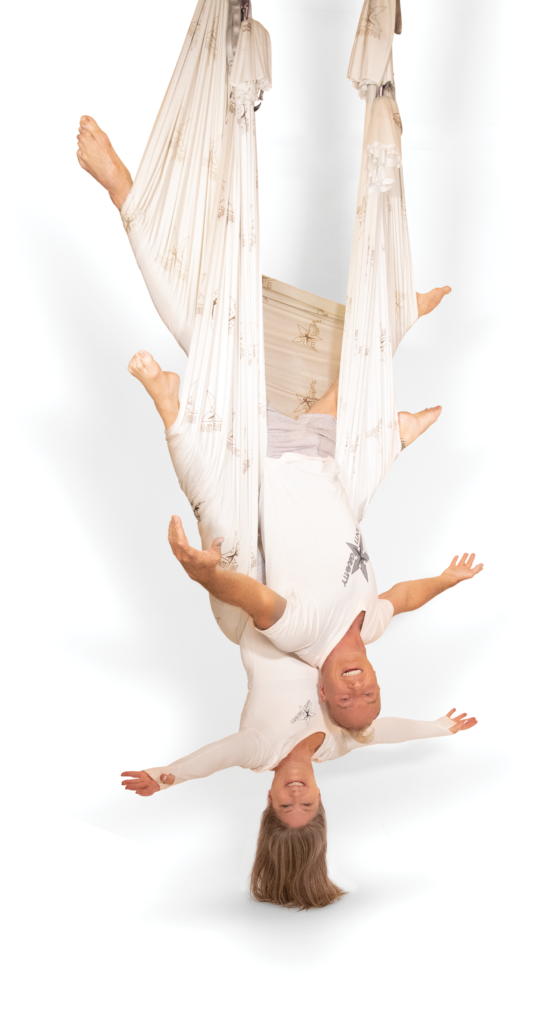
How does Christopher Harrison BUS’84 describe the work he and Darlene Casanova BFA’85 do? “Darlene is Tinkerbell to my Peter Pan alter ego—we love teaching people to fly.”
Harrison and Casanova met at the U as dance and musical theater students, sharing dreams of Broadway that later became reality. Today, however, the two are more likely to be found above a stage than on it. Harrison founded aerial entertainment and fitness company AntiGravity, Inc. in 1991, first coming up with the idea for aerial choreography after his dance troupe was booked at a small-staged but high-ceilinged nightclub. With no option but to go vertical, Harrison designed a special silk hammock and created a transcendent aerial performance.
The show was a hit. Plus, adds Harrison, “Once we learned how to hang from our hips upside down, we found we could get rid of our back pain by doing so.” He was able to ditch his twice-weekly chiropractor visits thanks to these “zero-compression” inversions, which provide spinal traction. Now, the company trains and licenses instructors around the world to teach yoga and fitness classes using AntiGravity silk hammocks.
“It really has changed how fitness looks to me,” says Casanova, AntiGravity’s first franchisee and now its global curriculum director. In addition to decompression, she notes, AntiGravity classes are low-impact and build strength and flexibility at the same time. “I can actually say I’m stronger and more flexible now than I was at the peak of my performance career.”
Eager to try it? Look for a certified AntiGravity instructor near you, and follow Harrison and Casanova’s advice:
- Start with AntiGravity Fundamentals. This intro class teaches you the basics of using the hammock.
- Give it a few classes. Don’t give up if it feels difficult or weird at first. “By the third time, you’ll be so addicted,” says Harrison.
- Trust in AntiGravity’s safety measures. The company prioritizes safety with strict requirements for rigging the hammocks, which can support 1,000 lbs.
Web Extra
In this extended interview, Harrison and Casanova share more about their journey from the U to Broadway to teaching people around the world an innovative brand of fitness.
What was your time at the University of Utah like?
Casanova: Christopher and I met in the modern dance department and we became fast friends because we were both interested in musical theater. I have such fond memories of being there in the old dance building, and we would be there from, like, six in the morning until three in the morning. The things that we were able to do as creative humans was just a wide, beautiful array of opportunity. Our time at the U was very, very special.
Harrison: While I was studying dance, I was also a cheerleader, which was frowned upon in the dance department because of the risk of injury. And sure enough, I blew out my knees cheerleading and they got to say, “We told you so.” But the U was great because it gave me a place to continue my education in other areas. So I studied singing, acting, and kinesiology, and all those things really added up to a much more well-rounded career, I think. My degree is a bachelor of university studies since I changed my major so many times. The thing I found most valuable at the University of Utah was learning tenacity and diligence of practice. I really learned how to stay focused and how to expand my curiosity and wonderment for creativity and exploration. The training I got there really prepared me for a career in New York in the most surprising ways. I was forced to study the classics, from Ibsen and Chekhov to Puccini and Verdi. Ironically, the first professional job I had in New York was at the Metropolitan Opera. I was so grateful to have a good education.
Did you both have dreams of Broadway?
Harrison: After I blew out my knees, the doctor told me, “There’s no way you’re going to be able to dance again.” I said, “When are you releasing me?” He told me July 15, 1984. That was a year away, but I bought a one-way ticket, put it on my wall, and said, “In one year, I’m moving to New York to dance on Broadway.” Everybody felt so sorry for me. They were like, “That poor kid. He’s got another thing coming.” But I was like, “No one’s going to tell me no.” As soon as my knees were working again, I started dancing again. I got cast in the movie Footloose and made enough money to move to New York. If you come to New York with a hit movie under your belt, you have a leg up. So I found success straight away in touring Broadway shows.
Casanova: I always knew I was going to end up in New York too, but I didn’t know when. After I graduated, I was on a trip to Europe with my girlfriend. We had a layover in New York, and I got off the plane—I had 50 bucks in my pocket—and I said, “I’m not getting back on.” It took me a little bit of time to get work, but I ended up doing a number of touring Broadway shows. In fact, Christopher and I had similar career paths. He played Tumblebrutus in Cats in Germany, while I was playing Dinah in Starlight Express in a neighboring city.
Christopher, where did you get the idea for AntiGravity?
Harrison: When I was dancing on Broadway I had afternoons free, so I started teaching at Sutton Gymnastics. I met other people who had gymnastics abilities and who wanted to perform, and we got an opportunity to perform for the New York City Marathon post party. They wanted something with really high energy. I put together a show combining acrobatics and dance and it went through the roof. The next thing you knew, we got a feature at Radio City Music Hall, the Miss America Pageant, the NBA All-Star game and that was just our first year! We have been deep in pop culture with commissions that include the MTV Video Music Awards, the Grammys, B.E.T. Awards, Latin Music Awards, and even the Academy Awards. We’ve done hundreds of high-profile commissions and created our own original productions that have played New York City and toured concert halls in the U.S. and overseas.
We’re now celebrating our 33rd year in business. Our events business and aerial arts training center is based in Orlando, Florida, where we have performance contracts with Disney and Universal. We just finished creating the aerial effects used for the Broadway production of One More Time, the Britney Spears musical.
To come full circle, I wound up choreographing part of the closing number for the 2002 Winter Olympics at Rice-Eccles Stadium, where I was once a cheerleader. I think that might be my favorite credit—either that or Obama’s ’09 inauguration.
Where did the idea for AntiGravity Fitness come from?
Harrison: The AntiGravity entertainment company got a contract to do a nightclub that had a very small stage but really high ceilings. I said, “I guess all we can do is go up.” None of us were aerialists, but I knew we could hang in hammocks. I said, “Let’s just hang some fabric hammocks from the ceiling and dance over the people. They’re gonna love it.” Sure enough, it was very successful. And once we learned how to hang upside down, we also learned that we could get rid of our back pain by doing so. I used to go to a chiropractor twice a week because I had several compression injuries, but I literally never had to go back.
As soon as we launched the fitness program, it was a hit. AntiGravity Fitness is now in its 16th year in business.
Darlene, how did you get involved in AntiGravity?
Casanova: I had opened up a business in Salt Lake called Imagination Place. It was a music and movement center for children and adults. Christopher walked through my doors one day and he told me what he was up to with AntiGravity. I was wowed. I said, do you realize what you have here? I became one of their first licensees. It’s such an interesting and wonderful technique. I started offering AntiGravity classes along with the other programs I had at Imagination Place, and then I began working very closely with Christopher to design and create the AntiGravity kids program.
Years later, they were looking for a new director of curriculum and training at AntiGravity. I sold my business and became AntiGravity’s curriculum director. Christopher and I go through the curricula often and fine-tune it. Quality is really important, and safety is number one. I train instructors all over the world in facilities that teach AntiGravity, and I also train other trainers. I’ve just returned from a three-week training at the Four Seasons in the Maldives. It’s a tough job, but someone has to do it [laughs].
Harrison: We have licensees in more than 50 countries and have certified over 10,000 AntiGravity Yoga instructors globally. The AntiGravity Lab is in the heart of Manhattan and the AntiGravity National Training Center for Aerial Arts is in Orlando. I am living squarely in my passion, providing opportunities for athletes and teaching everyday people to fly. I’m doing it with my dear classmate and friend Darlene. Who knew that is what all my great training at the U would add up to? I feel truly blessed.



Sign us up. Looks like a bad back blessing.
Many people find relief for back pain. Check out antigravityfitness.com for a studio near you. Be sure to go with an AG certified instructor. Take the bad out of your back with our special form of traction therapy that is totally accessible and effective. I get to see it all over the world.